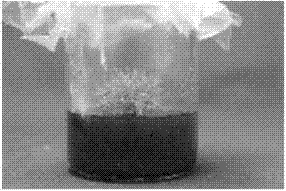Cryptomeria fortunei tissue culture rapid-propagation method
A technology of tissue culture and cedar, applied in horticultural methods, botany equipment and methods, horticulture, etc., can solve the problems of basic medium and combined hormone selective culture experiments, unsuitable for individual reproduction and cultivation of cedar with excellent genotypes, etc. , to achieve the effects of large-scale production, short cultivation period and large reproduction
- Summary
- Abstract
- Description
- Claims
- Application Information
AI Technical Summary
Problems solved by technology
Method used
Image
Examples
Embodiment 1
[0022] Select a robust cedar stem section, cut off the needles on the stem section, cut the stem section into about 4cm, wash it with running water for 1~2h, sterilize it in 75% ethanol for 30s, and then use 50% 84 disinfectant (Contains a small amount of Tween-20, add one drop per 50mL) Disinfect for 10 minutes, rinse with sterile water 8 times, then cut the stems into about 2cm, inoculate in medium for inducing adventitious buds, and start to produce adventitious buds after 8 days of light-induced culture ; After the adventitious buds are produced, select the young shoots that are growing and strong and transfer them to the rooting medium 1, and then cultivate them in the dark for 2-15 days, then put them under the light and cultivate them for 2-30 days, and then transfer them to the rooting medium 2. 10d Started rooting. Among them, the medium for inducing adventitious buds is: DCR+0.1~2.0mg / L 6-BA+0.1~2.0mg / L IBA+0.001~0.01mg / L TDZ+0.5~5.0g / L AC; rooting medium 1 is : 1 / 2...
Embodiment 2
[0024] Repeat the experiment according to the same steps as described in Example 1. At each induction culture stage, different doses of activated carbon (0.5-10.0 g / L) were added respectively, wherein 0.5-5.0 g / L of activated carbon was added to the medium for inducing adventitious buds, Adding 1.0-10.0 g / L of activated carbon to rooting medium 1 and adding 0.5-5.0 g / L to rooting medium 2 can obviously promote the growth and robustness of Cedar cedar, with green leaves, and effectively prevent the occurrence of yellowing and browning of seedlings. The induction rooting phase promotes rooting.
Embodiment 3
[0026] Repeat the experiment according to the same steps described in Example 1. In the rooting induction stage, the macroelements in the 1 / 2DCR medium used are reduced by 1 / 2 compared with conventional DCR. The results are shown in Table 1, which can significantly promote the induction of rooting and increase the rooting rate to 85%.
[0027] Table 1 Effects of macroelements in medium on rooting of Chinese cedar
[0028]
PUM
 Login to View More
Login to View More Abstract
Description
Claims
Application Information
 Login to View More
Login to View More - R&D
- Intellectual Property
- Life Sciences
- Materials
- Tech Scout
- Unparalleled Data Quality
- Higher Quality Content
- 60% Fewer Hallucinations
Browse by: Latest US Patents, China's latest patents, Technical Efficacy Thesaurus, Application Domain, Technology Topic, Popular Technical Reports.
© 2025 PatSnap. All rights reserved.Legal|Privacy policy|Modern Slavery Act Transparency Statement|Sitemap|About US| Contact US: help@patsnap.com



